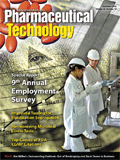AAIPharma Returns to its Roots
The integrated services model is the "next big thing" in CMC and early development services.
Out of bankruptcy and focused on its contract research business again, AAIPharma (Wilmington, NC) is investing in its traditional core strength: chemistry, manufacturing, and control (CMC) development services.

Jim Miller
Bolstered by a $30-million equity infusion from its current private investors, the company will make significant upgrades to its analytical, formulation, and manufacturing capabilities. AAI-Pharma's recently appointed senior vice-president for operations, Lee Karras, provided an update about the plans during November's AAPS Annual Meeting.
AAIPharma will make a major investment in its Charleston, South Carolina parenteral manufacturing facility, spending $1.3 million on various upgrades. Planned projects will improve people and material flow, provide better engineering controls, and add GMP warehouse space. The improvements, says Karras, will enable the Charleston facility to meet the compliance standards of the Medicines and Healthcare products Regulatory Agency (MHRA, the UK regulatory body) and European Union (EU) compliance standards, so that clinical-trial materials manufactured at the facility can be exported to EU countries. The 48,000-ft2 Charleston facility, which has two filling suites and a 54-ft2 lyophilization unit, already has FDA approval.
AAIPharma also is making investments in its formulation and analytical-services capabilities, service areas where it was once an industry leader. Karras says that the company has managed to retain the scientific talent in those areas from the prebankruptcy days. Nonetheless, AAIPharma suffered from under-investment during the years when it tried to remake itself as a specialty-pharmaceuticals company. The company is planning to invest at least $500,000 to update instrumentation, including ultra HPLC and GC–MS capabilities. Formulation and analytical-chemistry services are provided from the company's Wilmington, North Carolina facility, which also manufactures solid-dose clinical trial material (CTM). The company also has a small laboratory-services group in New Ulm, Germany.

Company Web Sites
Along with upgrading its existing capabilities, AAIPharma will be expanding its CMC development services offerings, according to Karras. The company recently launched a physical-chemistry practice. Physical Chemistry is a hot area in which opportunities are underscored by the recent acquisition activity in that area, including Aptuit's (Greenwich, CT) purchase of SSCI (Fort Wayne, IN) and SAFC's (St. Louis, MO) acquisition of Pharmorphix (Cambridge, UK). Karras said the company is likely to add clinical packaging and distribution in the coming year.
As it reorganizes, AAIPharma is pursuing an integrated services model, packaging together clinical and nonclinical capabilities to target specific market segments. It is currently promoting packaged services under the brand names "AAIGeneric," "AAIBiotech," and "AAIOncology." The latter offering was created following the recent acquistion of Cvitkovic & Associés Consultants, S.A., (CAC) a Paris-based CRO specializing in oncology drug development. CAC has experience in running early-stage clinical trials as well as large, international Phase II/III trials for oncology drugs.
A tour of the exhibit hall at this year's AAPS Annual Meeting showed that the integrated services model is the "next big thing" in CMC and early-development services. One of the biggest proponents is Aptuit, whose model calls for integrated API and dosage-form development and manufacturing capabilities tied together with a sophisticated project-management system. Aptuit recently announced two major acquisitions to fill out its service offerings: the API manufacturing operations of EaglePicher Pharmaceutical Services, based in Lenexa, Kansas, and SSCI, a provider of solid-state analytical-chemistry services. Aptuit already had preclinical, formulation, CTM manufacturing, and packaging services as a result of its acquisitions last year of Quintiles' (Research Triangle Park, NC) nonclinical operations and clinical packager Almedica. Almac Group (Craigavon, UK) and Azopharma (Miami, FL) are other examples of CROs offering an integrated services package.
Back from the brink
The emergence of sourcing options in the low-cost countries of Asia has provided a learning experience for both buyers and sellers of contract services. Nowhere has this learning process been more evident than in the discovery services arena. A year ago, North American and European providers of discovery services were under tremendous pressure as major pharmaceutical companies seemed intent on pushing down everyone's prices to Asian levels. A year later, Western discovery CROs are more optimistic. While the flow of discovery, chemistry, and biology projects to Asia continues to grow, Western CROs are learning to compete more effectively.
Part of the improvement stems from the fact that pharmaceutical companies are becoming more sophisticated in deciding where to place their projects. They are differentiating their projects and providers with criteria such as speed, experience, innovation, and intellectual property (IP) considerations, as well as cost and matching requirements and capabilities more closely.
"It seems like cost was a major driver," says Mike Trova, senior vice-president of discovery services for Albany Molecular Research, Inc. (AMRI, Albany, NY). "I think the pendulum is swinging back to a middle ground now where it doesn't have to be one or the other." Pharmaceutical clients are growing more comfortable placing projects in locations that best match the project's requirements, he notes.
"We have had to react to the developing Asian CROs," says David Phillips, senior vice-president of sales and marketing for UK-based BioFocus DPI (Saffron Walden, UK), a subsidiary of Galapagos NV (Mechelen, Belgium). "Not by competing head-to-head, but rather by trying to position our unique selling points to be more competitive."
Phillips says BioFocus DPI has become more targeted in its business development efforts. "We are much more selective about the type of work we pitch for," says Phillips. "We'll tell a pharmaceutical company, 'This may not be the right project for us.' We try to help them position projects with us more effectively."
Going global has become an important strategy for the larger discovery CROs. BioFocus expanded beyond Europe by acquiring the remnants of Discovery Partners International (San Diego, CA), a US-based discovery company, and initiated collaborative arrangements for chemistry services with two Indian companies.
AMRI recently opened its second facility in India, focused on early-stage drug discovery research, including custom chemical synthesis and medicinal chemistry. The company opened a facility in Singapore in 2005. "Diversification and globalization of our business are key," says Trova. "We can offer differing expertise and a variety of cost models around the world, and it allows us to expand our customer base."
Projects that require speed frequently stay in the United States. "Timing is everything, especially for small companies," says Deborah Minor, whose company, Drug Discovery Alliances (Bath, NC), represents approximately 40 small- to mid-sized CROs and CMOs in the United States. "Communication is another factor. If you want information about your API real-time, that's not always easy to get with the time differences."
Western CROs also may find that developments in the Asian markets may close some of the cost gap. The supply of key resources, including staff, energy, and water, is often unreliable, and their costs seem to be escalating. Phillips from BioFocus DPI notes that Indian salaries have risen, so the comparative advantage has narrowed there. Trova at AMRI sees some price pressures already beginning to surface in China, with escalating salaries and the cost of doing business there. That could lead to other countries becoming bases for discovery work.
"Big Pharma began exploring options around the world years ago," Trova says. "I would suggest that there will be developing markets in other parts of the world."

PacBio Chosen as Tech Partner for Global Alzheimer’s Disease Research Project
April 23rd 2025The project, the North African Dementia Registry, will unite multiple entities for the purpose of developing a comprehensive dataset to advance the research community’s understanding of Alzheimer’s disease and other dementias in diverse populations.